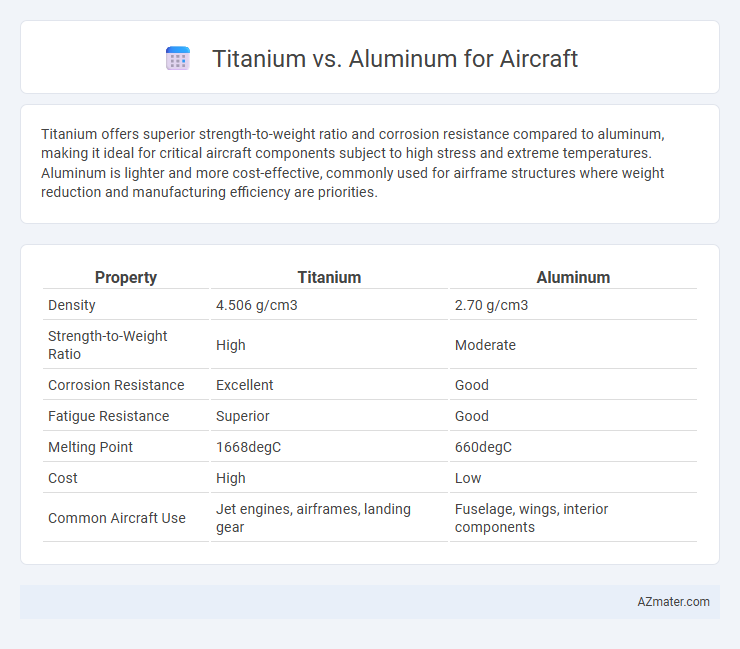Titanium offers superior strength-to-weight ratio and corrosion resistance compared to aluminum, making it ideal for critical aircraft components subject to high stress and extreme temperatures. Aluminum is lighter and more cost-effective, commonly used for airframe structures where weight reduction and manufacturing efficiency are priorities.
Table of Comparison
| Property | Titanium | Aluminum |
|---|---|---|
| Density | 4.506 g/cm3 | 2.70 g/cm3 |
| Strength-to-Weight Ratio | High | Moderate |
| Corrosion Resistance | Excellent | Good |
| Fatigue Resistance | Superior | Good |
| Melting Point | 1668degC | 660degC |
| Cost | High | Low |
| Common Aircraft Use | Jet engines, airframes, landing gear | Fuselage, wings, interior components |
Introduction to Aircraft Material Selection
Titanium and aluminum are critical materials in aircraft manufacturing due to their high strength-to-weight ratios and corrosion resistance. Titanium offers superior strength and heat resistance, making it ideal for high-stress components such as engine parts and airframe structures. Aluminum provides excellent lightweight properties and cost-effectiveness, commonly used in fuselage and wing assemblies where weight reduction is essential.
Overview of Titanium and Aluminum
Titanium offers an exceptional strength-to-weight ratio, corrosion resistance, and high-temperature endurance, making it ideal for critical aircraft components such as engine parts and structural frames. Aluminum boasts lightweight properties, excellent machinability, and cost-effectiveness, widely used in fuselage panels, wing assemblies, and interior structures. Both metals contribute to aircraft performance and fuel efficiency, with titanium preferred for high-stress areas and aluminum for overall airframe construction.
Mechanical Properties Comparison
Titanium exhibits superior strength-to-weight ratio and higher tensile strength compared to aluminum, making it ideal for critical aircraft components requiring durability under stress. Its excellent corrosion resistance and ability to withstand extreme temperatures surpass aluminum, enhancing safety and longevity in aerospace applications. Although aluminum offers advantages in lower density and ease of fabrication, titanium's mechanical properties provide greater fatigue resistance and structural performance for demanding aircraft environments.
Weight and Density Differences
Titanium has a density of approximately 4.5 g/cm3, which is significantly higher than aluminum's density of about 2.7 g/cm3, making aluminum nearly 40% lighter in weight. Despite its heavier density, titanium offers superior strength-to-weight ratio and corrosion resistance, allowing for thinner components and weight savings in critical aircraft structures. Aircraft designers often balance these materials, utilizing aluminum for lightweight parts and titanium where strength and temperature resistance are paramount.
Corrosion Resistance and Durability
Titanium exhibits superior corrosion resistance compared to aluminum, particularly in harsh and saline environments, making it ideal for critical aircraft components exposed to moisture and chemicals. Its exceptional strength-to-weight ratio enhances durability, reducing maintenance costs and extending service life under cyclic stress conditions. While aluminum is lighter and more cost-effective, its susceptibility to corrosion necessitates protective coatings, which can add weight and complexity to aircraft design.
Cost and Availability
Titanium offers superior strength-to-weight ratio and corrosion resistance but comes at a significantly higher cost and limited availability compared to aluminum, which is abundant and cost-effective for large aerospace applications. Aluminum's widespread use in aircraft manufacturing is driven by its lower raw material and processing costs, facilitating easier sourcing and large-scale production. The choice between titanium and aluminum hinges on balancing performance benefits against budget constraints and supply chain reliability in aerospace projects.
Manufacturing and Machinability
Titanium offers superior strength-to-weight ratio and corrosion resistance compared to aluminum, making it ideal for critical aircraft components but presents challenges in manufacturing due to its high reactivity and difficulty in machining. Aluminum is favored for its excellent machinability, lower cost, and ease of fabrication, despite having lower strength and fatigue resistance than titanium. Advanced machining techniques such as cryogenic cooling and specialized tooling are often required to efficiently process titanium alloys in aerospace manufacturing.
Applications in Modern Aircraft
Titanium is extensively used in modern aircraft for critical structural components, engine parts, and landing gear due to its exceptional strength-to-weight ratio and corrosion resistance. Aluminum remains dominant in fuselage panels and wing structures because of its lightweight properties and ease of manufacturing. Advanced aircraft designs often combine titanium and aluminum to optimize performance, durability, and fuel efficiency.
Environmental and Maintenance Considerations
Titanium offers superior corrosion resistance compared to aluminum, reducing the need for frequent maintenance and extending aircraft lifespan while minimizing environmental impact from chemical treatments. Aluminum is lighter and less expensive but requires more frequent inspections and protective coatings to prevent corrosion, increasing the use of environmentally harmful materials. The higher durability and recyclability of titanium contribute to lower lifecycle emissions and waste, making it a more sustainable choice for long-term aircraft operations.
Conclusion: Choosing the Right Material
Titanium offers superior strength-to-weight ratio and excellent corrosion resistance, making it ideal for high-stress aircraft components. Aluminum remains favored for its lightweight, cost-effectiveness, and ease of fabrication, suitable for less critical parts. Selecting between titanium and aluminum depends on balancing performance requirements, weight reduction goals, and budget constraints in aircraft design.

Infographic: Titanium vs Aluminum for Aircraft
 azmater.com
azmater.com